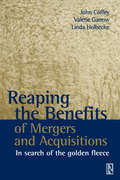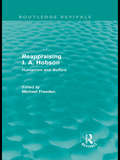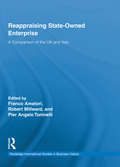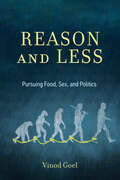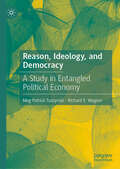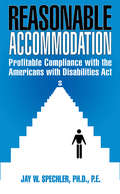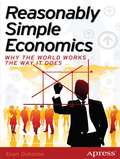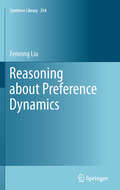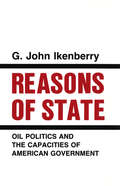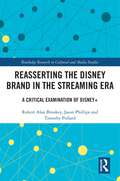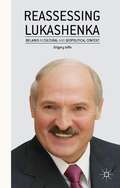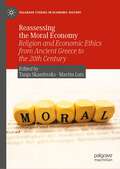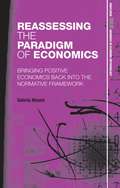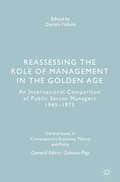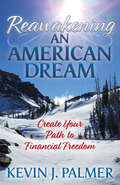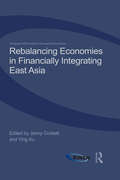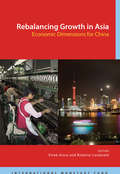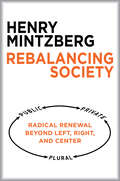- Table View
- List View
Reaping the Benefits of Mergers and Acquisitions: In Search Of The Golden Fleece
by John Coffey Linda Holbeche Valerie GarrowWill the early years of the new century continue to witness the huge growth in merger and acquisition activity which marked the end of the last? The chances are that they will - witness the value of deals carried out by the top five investment banks in the first quarter of 2001 alone ($456.2 billion). The quest for the golden fleece is alive and well. Will the majority of M&As continue to fail to achieve their potential value? This book is about breaking out of the cycle of grand strategy, great prospects, poor implementation, lost opportunities. The authors believe that it is possible for M&As to realise their value - and more. Bringing home the golden fleece involves more than just setting sail in quest for riches. It's about understanding the destination/end game, and working out the most appropriate route. This book has been written with the practitioner in mind, with the thirteen chapters split into three sections. The first section provides an overview of the merger process and outlining the key elements of success. Section Two focuses on the nuts & bolts of managing the integration process - from transition to full integration. Illustrated by a detailed case study of Articon Integralis AG, the leading supplier of IT Security Solutions and Services in Europe. The final section looks at the themes that can make or break mergers - creating the culture of the new organisation, communications, retention and the roles of line managers and HR. Each section is supported by checklists that should be helpful whether you are a novice at the merger game or an expert.
Reappraising J. A. Hobson: Humanism and Welfare (Routledge Revivals)
by Michael FreedenJ. A. Hobson was one of the most influential social, economic and political theorists of late nineteenth- and early twentieth-century Britain. In this volume, first published in 1990, eight scholars reassess the importance and relevance of his work today and affirm him as a major British thinker. These original studies place Hobson in context by explaining his intellectual antecedents: Cobden, Ruskin, nineteenth-century social and psychological theories and economic thought. The book provides an overview of the novelty and incisiveness of Hobson's contribution to British liberal theory and radical practice. Historians, economists, social and political theorists and students of international affairs will find this an important book for a fuller understanding of early twentieth-century British progressive thought.
Reappraising State-Owned Enterprise: A Comparison of the UK and Italy (Routledge International Studies in Business History)
by Franco Amatori Robert Millward Pier Angelo ToninelliAfter a quarter century of almost general condemnation and rebuttal of the entire nationalization experience, it appears that there are second thoughts about governmental direct intervention in the economy. Reappraising State-Owned Enterprise deals with a topic often undervalued in the past decade but which now, with the crisis of 2008-2009, calls for greater attention: the direct intervention of the State as Entrepreneur. The collection of essays in this volume – prepared by some of the leading authorities in the field – offers a contribution to this debate by providing a balanced assessment of two of the most relevant experiences of mixed economies, the United Kingdom and Italy. In this respect, a comparison between these two countries is very much appropriate since in both nations the State played an important role as "Entrepreneur" starting in the early 20th century. In Great Britain and Italy, the heyday of the "State as Entrepreneur" was in the years right after WWII when it was used as a tool for promoting a modern society in which citizens acquired a stronger sense of belonging to their nations. The UK and Italy saw the State take on a too-pervasive role in the 70s; the two nations responded in different ways. In the 1980s Great Britain embarked on a harsh process of privatizations while Italians struggled on until finally submitting to privatizations in their nation in the following decade. The deep crisis of the final years of the 21st century forced both nations to reconsider State interventions as an appropriate tool in order to protect the wellbeing of the national economy.
Reason and Less: Pursuing Food, Sex, and Politics
by Vinod GoelA new, biologically driven model of human behavior in which reason is tethered to the evolutionarily older autonomic, instinctive, and associative systems. In Reason and Less, Vinod Goel explains the workings of the tethered mind. Reason does not float on top of our biology but is tethered to evolutionarily older autonomic, instinctive, and associative systems. After describing the conceptual and neuroanatomical basis of each system, Goel shows how they interact to generate a blended response. Goel&’s commonsense account drives human behavior back into the biology, where it belongs, and provides a richer set of tools for understanding how we pursue food, sex, and politics. Goel takes the reader on a journey through psychology (cognitive, behavioral, developmental, and evolutionary), neuroscience, philosophy, ethology, economics, and political science to explain the workings of the tethered mind. One key insight that holds everything together is that feelings—generated in old, widely conserved brain stem structures—are evolution&’s solution to initiating and selecting all behaviors, and provide the common currency for the different systems to interact. Reason is as much about feelings as are lust and the taste of chocolate cake. All systems contribute to behavior and the overall control structure is one that maximizes pleasure and minimizes displeasure. Tethered rationality has some sobering and challenging implications for such real-world human behaviors as climate change denial, Trumpism, racism, or sexism. They cannot be changed simply by targeting beliefs but will require more drastic measures, the nature of which depends on the specific behavior in question. Having an accurate model of human behavior is the crucial first step.
Reason of State
by Thomas PooleThis historically embedded treatment of theoretical debates about prerogative and reason of state spans over four centuries of constitutional development. Commencing with the English Civil War and the constitutional theories of Hobbes and the Republicans, it moves through eighteenth-century arguments over jealousy of trade and commercial reason of state to early imperial concerns and the nineteenth-century debate on the legislative empire, to martial law and twentieth-century articulations of the state at the end of empire. It concludes with reflections on the contemporary post-imperial security state. The book synthesises a wealth of theoretical and empirical literature that allows a link to be made between the development of constitutional ideas and global realpolitik. It exposes the relationship between internal and external pressures and designs in the making of the modern constitutional polity and explores the relationship between law, politics and economics in a way that remains rare in constitutional scholarship.
Reason, Ideology, and Democracy: A Study in Entangled Political Economy
by Richard E. Wagner Meg Patrick TuszynskiDemocratic political systems are often thought to be preferable to all others for supporting liberty. Around the world, nations that are more democratic tend to be freer across various aspects of life and human experience. This book undertakes a social scientific analysis of this claim and finds it to be wanting. The reality of democratic systems does not adhere to popular rhetoric. One of the key reasons for this is that our system is an entangled system, one in which the realm of the political and commercial are so intertwined that they cannot be easily separated. Businessmen have political interests, and politicians have commercial interests. The implication of this entanglement is that alleviating the problems that emerge in democratic systems is not a simple matter of rolling back damaging interventions. Due to the logic of entanglement, returning to a “free market” is not possible in most cases. The authors pull economics back to its classical roots to analyze the social orders that best allow people to live together. The world is not constantly aiming at placidity, as the prevailing economics of equilibrium would have us think. We live in a world of change and turbulence, so our social science requires a framework that deals with this turbulence robustly. Classical economists beginning with Adam Smith sought to uncover which forms of human association allowed us to live better together. The authors explain Smith’s observations, asking the same sorts of questions of readers today. Because the baseline assumption of entanglement does not allow one to divide the world so clearly into two distinct structures, the authors parallel Smith’s approach, focusing on forms of association rather than political or commercial structures. Focusing on human association, the authors help readers uncover the manifold structures humans have devised that allow them to tame the turbulence and live lives more harmoniously with others.
Reasonable Accommodation: Profitable Compliance with the Americans with Disabilities Act
by JayW. SpechlerReasonable accommodation is defined as any change in the work environment or in the way business is usually conducted that results in equal employment opportunity for an individual with a disability. With the Americans with Disabilities Act in full swing and more than 35,000 court cases on record, there is much to be done to get most companies into compliance.Reasonable Accommodation: Profitable Compliance with the Americans with Disabilities Act was designed to provide those responsible for diversity and implementing the ADA with specific benchmark examples of how companies have provided accommodations that have had a positive impact on profitability, quality, employee and customer relations.This masterfully written book covers many important topics dealing directly with the ADA. It also provides numerous technologies available that can greatly increase productivity and quality of performance for disabled employees, as well as a "who's who" of case studies including: AT&T, Boeing, Federal Express, Ford Motor Co., Bank of America, Digital Equipment, General Electric Co., IBM, Motorola, WAUSAU Insurance Co., Sears Roebuck, Philip Morris, and many more.
Reasonably Simple Economics
by Evan OsborneThe goal of Reasonably Simple Economics is, not surprisingly, simple: to help us think like economists. When we do, so much of the world that seemed mysterious or baffling becomes more clear and understandable--improving our lives and providing new tools to succeed in business and career. In a chatty style, economist Evan Osborne explains the economic foundations behind the things we read about or see in the news everyday: Why prices for goods and services are what they are How government spending, regulation, and taxation can both hinder and help the economy Why and how some people get fabulously rich How entrepreneurs reorganize society beneficially Why markets sometimes fail and when or if governments should intervene when they do How economics and statistics can explain such things as discrimination in hiring and providing services (and why discriminators are shooting themselves in the foot), why we're smarter than we've ever been, and how technology makes the idea of Earth's "carrying capacity" meaningless Along the way, you will learn the basic concepts of economics that well-educated citizens in democratic countries should know, like scarcity, opportunity cost, supply and demand, all the different ways economies are "managed," and more. In the manner of The Armchair Economist, The Undercover Economist, or Naked Economics, Osborne uses current examples to illustrate the principles that underlie tragedies like the Greek economy or the global market meltdown of 2008, and triumphs like the continuing dominance of Silicon Valley in the tech world or why New York City markets are stuffed with goods despite the difficulty in getting them there. As Osborne points out, the future, in economic terms, has always been better than the past, and he shows you how to use that knowledge to improve your life both intellectually and materially. What you'll learn How to think like an economist and better understand the world and your place in it Basic economic concepts like supply and demand and marginal costs and benefits How and why people "respond to incentives," and why this is a life-changing idea Why "the crowd" is invariably wise and what to learn from it Why speculators and "middlemen" improve life not just for themselves but for the rest of us Why living standards have risen dramatically in the last century and why they will continue to as time marches on Why taking advantage of "decentralized knowledge" to pounce on opportunity is critical for your success Who this book is for The audience for this book is anyone who wants to know answers to such questions as why the price of gasoline rises and falls dramatically, whether we are in fact "mortgaging our children's future" through deficit spending, what the economic principles behind every great fortune are, and anything else governed by the principles of economics (which is most things). Table of Contents Introduction Supply and Demand, Considered Separately Supply and Demand, Considered Together The Economics of Information or Knowledge Public and Private Decision Making Who Makes How Much, and Why The Middleman and the Entrepreneur Time and Risk The Entrepreneur and Some Economics of the Future The Things Only Government Can Do Macroeconomics: The Big, Often Blurry Picture Macroeconomics: Stabilizing the Economy, or Not Macroeconomics: The Short and the Long Runs
Reasoning about Preference Dynamics
by Fenrong LiuOur preferences determine how we act and think, but exactly what the mechanics are and how they work is a central cause of concern in many disciplines. This book uses techniques from modern logics of information flow and action to develop a unified new theory of what preference is and how it changes. The theory emphasizes reasons for preference, as well as its entanglement with our beliefs. Moreover, the book provides dynamic logical systems which describe the explicit triggers driving preference change, including new information, suggestions, and commands. In sum, the book creates new bridges between many fields, from philosophy and computer science to economics, linguistics, and psychology. For the experienced scholar access to a large body of recent literature is provided and the novice gets a thorough introduction to the action and techniques of dynamic logic.
Reasons for Being Bad: Why Leaders and Followers Behave Badly
by Barbara KellermanLeaders have various reasons for behaving badly, from the influence of others to being unwilling to control their desire for more. But why do people follow them? Using the extreme example of Nazi Germany, the author illustrates the different reasons followers put up with, or even actively support, a bad leader.
Reasons of State: Oil Politics and the Capacities of American Government (Cornell Studies in Political Economy)
by G. John IkenberryIn this lucid and theoretically sophisticated book, G. John Ikenberry focuses on the oil price shocks of 1973–74 and 1979, which placed extraordinary new burdens on governments worldwide and particularly on that of the United States. Reasons of State examines the response of the United States to these and other challenges and identifies both the capacities of the American state to deal with rapid international political and economic change and the limitations that constrain national policy.
Reasons to Pass: A Guide to Making Fewer and Better Investments
by Ralph BirchmeierConfidence and conviction are the keys to success in asset management. Analysts projecting these traits become more likely candidates for promotion; clients gravitate to portfolio managers who radiate assurance about future performance. However, these qualities do a disservice to optimal decision making and long-term investment performance. The future is too complex to justify such levels of confidence.In Reasons to Pass, the seasoned practitioner Ralph Birchmeier argues that an optimal portfolio-building strategy means patiently waiting for the few investments worthy of capital allocation. He outlines the principles required for success then examines specific reasons to pass on investments, detailing behavioral biases that disrupt optimal decision making. Although professional and retail investors alike are tempted by various opportunities, the wisdom of experience proves the value of prudence. An investing strategy built to last requires humility and the willingness to accept uncertainty; most of the time, it’s best to pass. Reasons to Pass brings investing back to the basics, helping readers navigate the complexity of the financial landscape and bringing clarity to the investment process. By underscoring the perils of overconfidence and the importance of humility, this book offers invaluable new perspective on investing for the long term.
Reasserting the Disney Brand in the Streaming Era: A Critical Examination of Disney+ (Routledge Research in Cultural and Media Studies)
by Robert Alan Brookey Jason Phillips Timothy PollardReasserting the Disney Brand in the Streaming Era investigates the evolution of the Disney brand at a pivotal moment – the move from content creation to acquisition and streaming – and how the company reasserted its brand in a changing marketplace. Exploring how Disney’s acquisition of Pixar, Marvel, Lucasfilm and Fox positioned the company to launch the Disney+ streaming service, the chapters look at the history of those acquisitions, and the deployment of the content, brands, and intellectual property from those acquisitions, through an analysis of the original content that appeared on Disney+. Offering a focused investigation of how the content offered from these various media brands was adapted for Disney+ so that it reflects the Disney brand, the authors illustrate through close textual analysis how this content reflects elements of the "Classic Disney Style." The analysis positions these texts in relation to their industrial contexts, while also identifying important touchstone texts (both television and film) in Disney's catalog. This comprehensive and thoughtful analysis will interest upper-level students and scholars of media studies, political economy, Disney studies, media industries and new technology.
Reassertion of Control over the Investment Treaty Regime
by Andreas KulickDriven by public opinion in host states, contracting parties to investment agreements are pursuing many avenues in order to curb a system that is being perceived - correctly or not - as having run out of control. Reassertion of Control over the Investment Treaty Regime is the first book of its kind to examine the many issues of procedure, substantive law, and policy which arise from this trend. From procedural aspects such as frivolous claims mechanisms, the establishment of appeals mechanism or state-state arbitration, to substantive issues such as joint interpretations, treaty termination or detailed definitions of standards of protection, the book identifies and discusses the main means by which states do or may reassert their control over the interpretation and application of investment treaties. Each chapter tackles one of these avenues and evaluates its potential to serve as an instrument in states' reassertion of control.
Reassessing Lukashenka
by Grigory IoffeWho is Mr Lukashenka? Do Belarusians support him out of fear and/or because they are blinkered, or there are other factors that help to explain his longevity as a national leader? The book seeks answers to these questions on the premise that Lukashenka's rule ought to be viewed in the context to which it truly belongs, that is, the context of Belarusian history and identity, not as a form of government (dictatorship) deceitfully imposed on an allegedly benighted people whom better positioned and informed outsiders seek to enlighten and liberate. The author makes use of two extensive personal interviews with President Lukashenka. They present a truly unique body of primary data. Many personal traits of Belarus's president are on full display in the interviews. Anybody willing to come up with his/her opinion about Lukashenka, not necessarily in line with that of the author of this book, can use this material.
Reassessing the Moral Economy: Religion and Economic Ethics from Ancient Greece to the 20th Century (Palgrave Studies in Economic History)
by Tanja Skambraks Martin LutzThis book examines the concept of moral economy originally established by E.P. Thompson, focusing on the impact of religious norms on economic practice. With each chapter discussing a different empirical case study, the interrelations of the economy and religion are explored from antiquity through to the 20th century. The long-term trajectory and comparative perspective allows for moral economy to be seen in relation to ancient Greek commerce, medieval pawn-broking, Christian and Jewish economic ethics, urban social politics during the Plague, the Jesuit mission in Paraguay, the Ottoman Empire, religion in modern American capitalism, and Catholic attitudes toward taxation.This book aims to provide insight into how moral thinking about the economy and economic practice has evolved from a long historic perspective. It will be relevant to students and researchers interested in economic history and cultural economics.
Reassessing the Paradigm of Economics: Bringing Positive Economics Back into the Normative Framework (Routledge Inem Advances In Economic Methodology Ser. #12)
by Valeria MosiniWhen President Reagan and Prime Minister Thatcher adopted the neoliberal doctrine as the paradigm of economics, there was no evidence that the move would have been successful, but thirty years on, the recurrent crises that culminated in 2008 suggest a serious mis-match between expectations and outcomes: a re-examination of the paradigm is in order. This book focuses on Milton Friedman’s formulation of the neoliberal doctrine, and analyses two aspects that were essential to turning it into a fully-fledged paradigm: the attribution of scientific status to positive economics, which led to informing public policies on the requirements of the market; and the characterisation of economic freedom as capable of promoting political freedom, which led to identifying free market with democracy. The book exposes Friedman’s methodological argument for attributing positive economics scientific status as a failure, and his characterisation of economic freedom as a delusion; it identifies in the emergence as the mainstream in economics of the neoclassical synthesis, which borrowed from Walras’ the mathematical treatment of equilibrium but not the ethical and social framework in which it was inscribed, a development that facilitated the transition from the Keynesian to the neoliberal paradigm. Dr. Mosini shows that the gigantic bail-outs carried out courtesy of the public purse, which institutionalised the practice of collectivising losses while keeping profits private, were no accident, but the consequence of the rethinking of the function of lender of last resort according to Friedman’s conception of rationality in relation to risk, combined with his interpretation of the 1930s recession. The book concludes that the neoliberal paradigm has served the interests of the economically powerful social strata it was designed to benefit extremely well, but that the deep, and deepening, injustice it has brought about calls for a complete rethinking of the paradigm of economics according to ethical principles respectful of human values. This book should be of interest to students and researchers of Political Economy, Economic Methodology, History of Economic Thought and Philosophy.
Reassessing the Role of Management in the Golden Age
by Daniela FelisiniThis book provides a critical reassessment of the role of the public sector during the Golden Age in both advanced and emerging economies. Contributions focus on a major player in the setting of mixed economies: the top managers of state-owned enterprises. Bringing together world-renowned scholars, this collection analyzes the actions of these managers and their contribution to the rise and fall of the mixed economy during the Golden Age, opening up a comparative perspective of the topic. The book forces readers to reconsider how crucial state-owned enterprises were for economic recovery and for the modernization of the production apparatus of many countries in Western Europe, India, Latin America and South Africa. Key chapters discuss state-owned enterprises in twentieth-century Europe, the managerial revolution in Italy, the role of the state in Argentine industrialization, and the organization of capital in the Indian economy. This insightful collection will appeal to scholars and students with an interest in economic history and the socio-economic impact of state-owned companies around the globe.
Reawakening an American Dream: Creating Your Path to Financial Freedom
by Kevin J PalmerReawakening an American Dream reveals the hidden secrets first-time millionaires have used to gain abundance or achieve financial freedom.
Reawakening the Magic: Bob Iger and the Walt Disney Company
by David J. Collis Ashley HartmanMickey Mouse, Snow White, and Buzz Lightyear strolled down Main Street at the grand opening of Hong Kong Disney in the Fall of 2005, pausing to snap selfies with enthusiastic children in their Mickey Mouse ears. Bob Iger, newly appointed CEO of The Walt Disney Company proudly watched the parade go by, but concerned for the future of the global corporation, he turned to colleagues and asked, "How many characters in this parade were created by Disney in the last ten years?" There was one. But the languishing Disney animation department was not the company's only problem. Disney was under pressure: the company had recently delivered poor financial results; ratings at the ABC network had fallen below competitors; Walt's nephew, Roy E. Disney, had stepped down from the Board after expressing his displeasure with the direction of the company under Iger's predecessor, Michael Eisner; and Comcast had made a $54 billion hostile bid to take over Disney only one year before. The situation for Disney looked bleak. Yet by December 2015 the tide had turned (Exhibit 1). The much-anticipated Star Wars: The Force Awakens was set to become the highest grossing film ever in the U.S. and earn over $2 billion worldwide. Frozen had just surpassed $1 billion in box office to become Disney animation's biggest success ever. In live action movies, Disney franchises, like Pirates of the Caribbean and Marvel's Iron Man, had produced multiple blockbuster hits. ESPN, ABC and other cable and broadcast properties were producing record profits. Attendance was up at Disney parks and cruise ships, while the Shanghai Disney Resort, the company's third and largest theme park in Asia, was scheduled to open in June 2016. Iger thought back to the Hong Kong Disney parade, reflecting on how far the company had come and the lessons he had learned about reawakening the Disney magic.
Reawakening the Magic: Bob Iger and the Walt Disney Company
by David J. Collis Ashley HartmanMickey Mouse, Snow White, and Buzz Lightyear strolled down Main Street at the grand opening of Hong Kong Disney in the Fall of 2005, pausing to snap selfies with enthusiastic children in their Mickey Mouse ears. Bob Iger, newly appointed CEO of The Walt Disney Company proudly watched the parade go by, but concerned for the future of the global corporation, he turned to colleagues and asked, "How many characters in this parade were created by Disney in the last ten years?" There was one. But the languishing Disney animation department was not the company's only problem. Disney was under pressure: the company had recently delivered poor financial results; ratings at the ABC network had fallen below competitors; Walt's nephew, Roy E. Disney, had stepped down from the Board after expressing his displeasure with the direction of the company under Iger's predecessor, Michael Eisner; and Comcast had made a $54 billion hostile bid to take over Disney only one year before. The situation for Disney looked bleak. Yet by December 2015 the tide had turned (Exhibit 1). The much-anticipated Star Wars: The Force Awakens was set to become the highest grossing film ever in the U.S. and earn over $2 billion worldwide. Frozen had just surpassed $1 billion in box office to become Disney animation's biggest success ever. In live action movies, Disney franchises, like Pirates of the Caribbean and Marvel's Iron Man, had produced multiple blockbuster hits. ESPN, ABC and other cable and broadcast properties were producing record profits. Attendance was up at Disney parks and cruise ships, while the Shanghai Disney Resort, the company's third and largest theme park in Asia, was scheduled to open in June 2016. Iger thought back to the Hong Kong Disney parade, reflecting on how far the company had come and the lessons he had learned about reawakening the Disney magic.
Rebalancing Economies in Financially Integrating East Asia (Routledge-ERIA Studies in Development Economics)
by Jenny Corbett Ying XuSince the Asian Financial Crisis (AFC) of 1997–98 large current account surpluses have accumulated in the countries of Asia and the Pacific with corresponding deficits elsewhere. The sharp plunge in global trade volumes during the global financial crisis has highlighted the need for ‘rebalancing’–focussing more on domestic sources of economic growth than on exports in some Asian economies. One key objective of the book is to elucidate the economic structures and policies that give rise to current account surpluses and imbalances and consider what policy adjustments could change them. Another objective is to show the link between financial systems, financial integration and the transmission of economic shocks between countries. The book offers new dimensions to understand ‘rebalancing’ and provides alternative and arguably more fundamental solutions to address imbalances. Rather than focusing on exchange rate misalignment, this book begins from the premise that the imbalances are a macroeconomic problem that reflects a mismatch between savings and investment in the surplus countries. Then, it examines exchange rate policies adopted by countries in the region and finds that part of the explanation for their currency strategy lies in their perceived need to build foreign exchange reserves to provide a buffer in case of instabilities. The book examines whether there are other possibilities for countries to insure against economic volatility by more actively and openly engaging with international capital markets. The studies show that closer financial integration, involving more open financial markets, with well-chosen partners, would be welfare-improving and should reduce the need for the counter-productive, self-insurance policies that result in foreign exchange accumulation.
Rebalancing Growth in Asia: Economic Dimensions for China
by International Monetary FundWith external demand for products decreased due to the recent economic crisis, the main way for Asian countries to maintain their rate of economic growth is to increase internal consumption. Focusing in particular on China, where private consumption makes up the smallest percentage of gross domestic product (GDP), this volume explores ways of increasing household consumption along with the possible employment consequences. Levels of personal and corporate saving are also considered, along with investment patterns. To better illustrate the data, tables and graphs regularly appear. The authors and editors all hold various positions at the International Monetary Fund (IMF). Annotation ©2011 Book News, Inc. , Portland, OR (booknews. com)
Rebalancing Public Partnership: Innovative Practice Between Government and Nonprofits from Around the World
by John BrothersIn the US, as in many other Western economies, federal and state government is working to become more involved with the nonprofit sector; a sector in which many of the organizations are singularly ill-prepared and strategically unaligned to fulfill the new role that is being asked of them. Based on his original research, John Brothers brings together leading thought leaders from the United States and around the world by exploring the prevailing attitudes and perceptions of the nonprofit sector towards government and vice versa and provides advice and direction to help both sides of the equation towards effective collaborative working. The main themes cover the nature and implications of regulatory reform on the sector and how non-government organizations should reengineer their practices. There are also chapters on some of the hot button areas of government contracting and political advocacy. The text includes best-practice examples, case studies as well as tools and templates from across the sectors. Both sides of this emerging partnership need fast-track education on each other’s capabilities, constraints and working practice. Dr Brothers’ contributors provide some very valuable perspectives and insights that should inform and direct this process.
Rebalancing Society: Radical Renewal Beyond Left, Right, and Center
by Henry MintzbergEnough of the imbalance that is causing the degradation of our environment, the demise of our democracies, and the denigration of ourselves. Enough of the pendulum politics of left and right and paralysis in the political center. We require an unprecedented form of radical renewal. In this book Henry Mintzberg offers a new understanding of the root of our current crisis and a strategy for restoring the balance so vital to the survival of our progeny and our planet.With the collapse of the communist regimes of Eastern Europe, Western pundits declared that capitalism had triumphed. They were wrong—balance triumphed. A healthy society balances a public sector of respected governments, a private sector of responsible businesses, and a plural sector of robust communities. Communism collapsed under the weight of its overbearing public sector. Now the “liberal democracies” are threatened—socially, politically, even economically—by the unchecked excesses of the private sector.Radical renewal will have to begin in the plural sector, which alone has the inclination and the independence to challenge unacceptable practices and develop better ones. Too many governments have been co-opted by the private sector. And corporate social responsibility can't compensate for the corporate social irresponsibility we see around us “They” won't do it. We shall have to do it, each of us and all of us, not as passive “human resources,” but as resourceful human beings.Tom Paine wrote in 1776, “We have it in our power to begin the world over again.” He was right then. Can we be right again now? Can we afford not to be?
